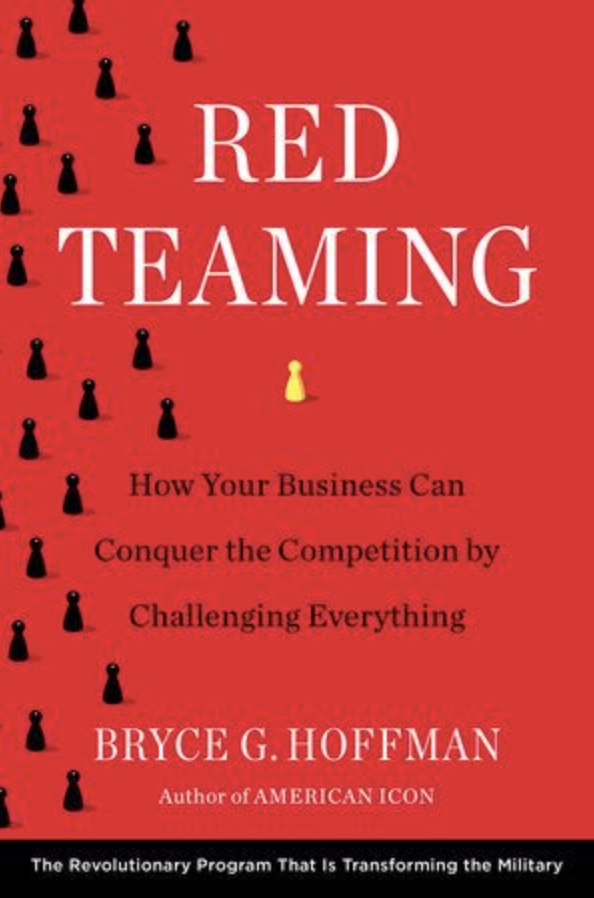Key Quote:
“Unflinching honesty will change the culture of your company for the better, making it more self-critical, more innovative, and better able to handle the challenges and opportunities of today’s rapidly changing world” (p. 107). — Bryce G. Hoffman
Key Points and Concepts
What is Red Teaming?
“Red teaming challenges your plans and the assumptions upon which they are based” (p. 50).
As a science, red teaming is a set of Analytic, Imaginative, and Contrarian techniques a team uses to overcome the limitations of human decision-making at a strategic planning level (p. 51).
The techniques are rooted in cognitive science and the psychology of decision-making. “Each of us, no matter how smart, or well educated, or well intentioned we may be, is unduly influenced by a dizzying array of cognitive biases and logical fallacies that skew our decision-making and lead us in unintended directions without us even being aware of it. Red teaming not only makes us aware of these biases and limitations, but also offers us a means of overcoming them” (p. 51).
Leaders should understand that listening to critical advice and allowing contrarian views does not mean they forfeit decision-making power; rather, it allows them to make better decisions. An engaged leader is essential to avoid some of the more counterproductive manifestations that are possible when red teaming isn’t utilized properly (p. 59).
Red teaming dates to the early 1800’s, when the Prussian army began using Kriegsspiel, or “war gaming” to train its officers. Represented by colored wooden blocks, the blue team would develop a battle plan and the red team would try to thwart it. The objective is to consider and test every possible weakness before giving the enemies that opportunity in battle (pp. 34-35).
Rotkoff spoke with an Iraqi Imam prior to the invasion of Iraq. He warned the American plan was oversimplified and ignored the complex clan, religious, and socio-cultural structures that would formulate a terror-stricken, post-war Iraq. Startled by the plan’s failure to consider this information, Rotkoff passed this on in a report to senior intelligence officials who never responded. When the Imam’s predictions ultimately came to fruition after the invasion, Rotkoff described it as a “watershed moment” that would go on to change how the Army strategized (p. 27).
The Psychology of Red Teaming
By the 1970s, the research of cognitive psychologists and behavioral economists, such as Dr. Daniel Kahneman and Dr. Amos Tversky, began to invalidate Rational Choice Theory–the idea that people generally make the best decision possible with the information provided to them (p. 67).
Most cognitive psychologists now believe we rely upon two basic mental decision-making processes: System 1 and System 2. System 1 is instinctive and associative. System 2 articulates judgements and makes choices. Our short-cut seeking brains often default to the non-attentive System 1 and jump to conclusions, landing us in some undesirable situations (pp. 67-69).
Our decision-making abilities are significantly influenced by a panoply of cognitive biases and heuristics. Cognitive Biases are inherent, systematic errors in our thinking that follow predictable patterns. Heuristics are mental shortcuts that help us make quick decisions (pp. 69-86).
Just because our brains are prone to these biases and like to take these shortcuts does not mean we are condemned to making poor judgement or bad decisions. “By being aware of these threats to rational thought, we can guard against them in ourselves” (p. 92).
How to Start Red Teaming
“Red teaming can be conducted formally or informally. It can be done by members of a company’s senior leadership team, an ad hoc committee made up of staff members selected for their critical thinking skills, or by a dedicated red team whose only job is to provide a fresh set of eyes to examine the organization’s strategies and plans” (p. 95).
It’s important that the red team is positioned close to the top of an organizational hierarchy. A red team is most effective when they are as close to senior leadership and decision-makers as possible while also maintaining a respectable degree of separation (p. 104).
“Unflinching honesty will change the culture of your company for the better, making it more self-critical, more innovative, and better able to handle the challenges and opportunities of today’s rapidly changing world” (p. 107).
The ideal size for a red team is between five and eleven people; lower would sacrifice diversity of perspective and a larger team would have trouble remaining focused (p. 107).
A good red team candidate is intelligent, imaginative, inquisitive, analytical, strategic, logical, self-aware, self-confident, and open-minded. To account for diversity of experience, you should also look for unusual educational background, unconventional career path, or distinctive personality (pp. 108-109).
Leaders should have excellent management and communication skills and be confident enough to speak truth to power, as they will liaise with senior leadership. Managing divergent thinkers also requires patience, an open mind, and willingness to change one’s own assumptions (p. 113).
The Problem and the Solution
“Complicated problems are those where the answer is knowable but not immediately apparent. Complex problems are much more open-ended and have more than one right answer, and plenty of wrong ones” (p. 121). Complicated problems can be addressed through a straightforward, reductionist approach while selecting the right techniques becomes essential to approach complex problems.
“Human beings are natural-born problem solvers. When we are presented with a problem, we are usually so eager to solve it that we do not take the time to examine it and make sure the problem, as it is stated, actually makes sense” (p. 124).
When analyzing problems, we should consider as many different ideas, explanations, and alternatives as possible before attempting to decide which one is the most desirable or correct (p. 127).
Putting it All Together
“There is no right way to red team. The techniques employed by a red team and the order in which they are used will depend on the nature of the problem, the time available, where the organization is at in its planning process, and the resources it is able to devote to red teaming” (p. 215).
It’s best to think of the provided techniques as a golf bag. A skilled, artful golfer knows which clubs to use in various situations and how to swing them (p. 216). However, there is an established set of rules that should be followed to ensure red teams “disagree agreeably” (p. 229).
For findings to be effective, they need to be communicated to senior leadership through established communication channels. “A red team should remain engaged in the project or initiative so that it can provide additional insights and watch for any signposts of change identified in its analysis” (pp. 226-228).
Questioning the Unquestionable: Analytic Techniques
Hoffman offers seven analytic techniques that red teams can use to “identify faulty logic and flawed thinking, explore alternative explanations that challenge groupthink and conventional wisdom, and close the gaps in [an] organization’s strategies and plans” (p. 174).
1. Thinking Critically: This involves asking difficult questions and taking a hard look at the answers while avoiding biases and logical fallacies (pp. 144-145).
2. Argument Dissection: Ask provoking questions and develop answers to better understand a given argument and utilize the technique as a starting point for red teaming (pp. 149-150).
3. Key Assumptions Check: Assumptions are things that may be true but cannot be proven to be true at this time. “Start by having the red team take a careful look at the plan and list all the stated and unstated assumptions that must be true for the plan to work” (p. 151).
4. Probability Analysis: Yields a list of assumptions that have a high probability of failure and the potential to impact the plan in a big way (p. 154).
5. String of Pearls Analysis: A mapping tool to visualize all the interconnected pieces of a plan and the contingent conditions necessary for all pieces to operate flawlessly (p. 156).
6. Stakeholder Mapping: Ensures potential adversaries are turned into allies and become active contributors to a plan’s success. This also ensures those already on your side stay on your side (p. 168).
7. Analysis of Competing Hypotheses (ACH): Useful when you need to make analytical judgements about a complex problem with substantive data to consider. Write out all potential hypotheses to describe a problem and eliminate those with complete or negligible alignment with a given dataset. “Draw tentative conclusions about each of the remaining hypotheses” (pp. 169-170).
Thinking the Unthinkable: Imaginative Techniques
Hoffman suggests seven imaginative techniques to “help you better understand your customers, competitors, and other important stakeholders” (p. 200).
- Four Ways of Seeing: Identify significant parties that may be impacted by your plan or strategy and split those constituencies into a quad chart. With your organization as X and the other as Y, populate the chart from the top left corner as follows: How X views X, Y views Y, X views Y, and Y views X. By identifying differences between the quadrants, an organization can consider how those differences can be exploited or how they provide an advantage or disadvantage (p. 177).
2. Outside-In Thinking: A form of analysis that begins with the broader environment and works its way back to the issue the red team is working on (p. 182).
3. Alternative Futures Analysis: Designed to reveal the different ways a strategy can unfold; allowing an organization to plan for the worst even as it prepares for the best (p. 183).
4. Pre-Mortem Analysis: Developed by cognitive psychologist Gary Klein, this helps red teams identify weaknesses in a plan before it is executed so undesirable outcomes are prevented (p. 186).
5. Being Your Own Worst Enemy: A role-playing exercise in which the red team assumes the role of a competitor, or other adversary, and then tries to figure out how they would react to a proposed strategy or plan (p. 191).
6. SWOT Analysis: Identifies a plan’s strengths, weaknesses, opportunities, and threats early in the planning process (p. 193).
7. Five Whys: When presented with a problem, asking five pointed ‘why’ questions can help clarify ambiguous or complex problems at the onset of analysis (p. 196).
Challenging Everything: Contrarian Techniques
These three techniques can help an organization remain innovative (pp. 210-212).
1. What-If Analysis: Designed to explore the consequences of an event that may have a low probability of occurring, but that would have a major impact if it did occur (p. 203).
2. Us vs. Them Analysis: This is helpful for settling long-standing disagreements between conflict parties within or between organizations (p. 205).
3. Devil’s Advocacy: This technique resembles the “Tenth Man Doctrine,” in which if nine members of a ten-person team agree on a plan, it is the duty of the tenth to adopt the contrary position and argue for it. “The red team’s job is to take a belief or assertion that is central to the organization’s strategy and make the most compelling case possible that the opposite is true” (p. 208).
Hoffman, B. (2017). Red Teaming: How Your Business Can Conquer the Competition by Challenging Everything. New York: Crown Business

Leaders should understand that listening to critical advice and allowing contrarian views does not mean they forfeit decision-making power; rather, it allows them to make better decisions. An engaged leader is essential to avoid some of the more counterproductive manifestations that are possible when red teaming isn’t utilized properly.
The positions with the most risk of being replaced by artificial intelligence are those that require knowledge of a repetitive, predictable process rather than those which depend upon improvisation and reacting to an ever-changing environment.
Devil’s Advocacy: This technique resembles the “Tenth Man Doctrine,” in which if nine members of a ten-person team agree on a plan, it is the duty of the tenth to adopt the contrary position and argue for it. “The red team’s job is to take a belief or assertion that is central to the organization’s strategy and make the most compelling case possible that the opposite is true.”
